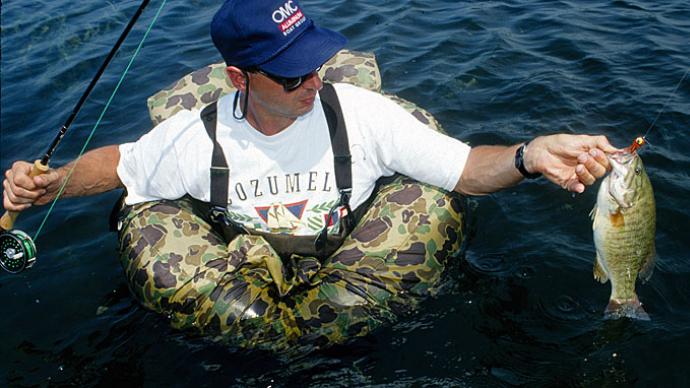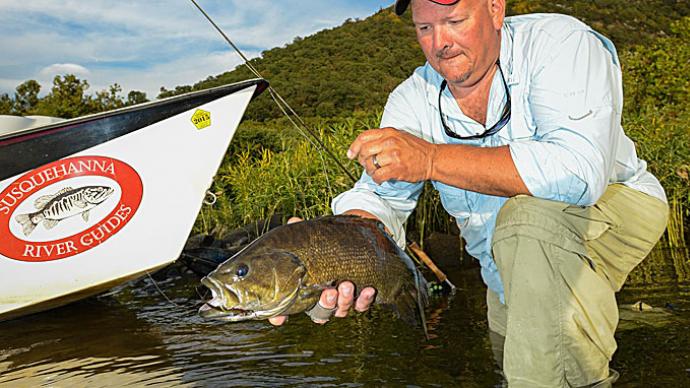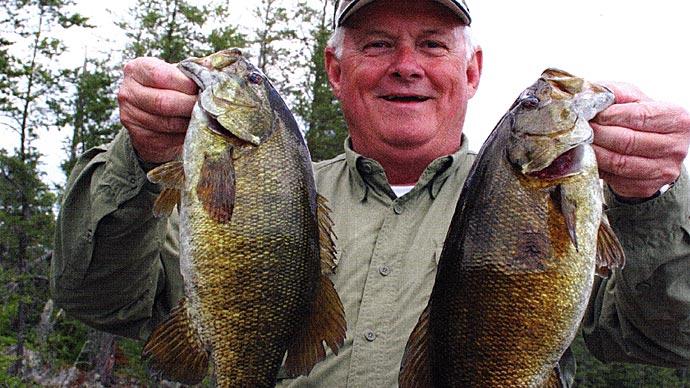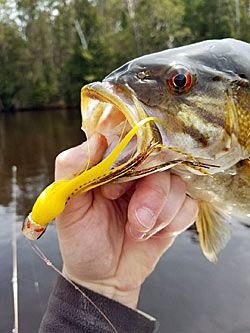
The best anglers share many traits, but none is more critical than a keen sense of observation. Count fly fishing guide Tony Sandrone among that group. He steers anglers to big bass on lakes and rivers across north-central Wisconsin. And much of their success can be traced back to what he sees during the spring.
Smallmouth head to the shallows as temperatures rise and daylight increases. Anglers usually aren’t far behind. Sandrone has watched them target prespawn, spawn, and post-spawn smallmouth. Instead of the small, earth-toned offerings usually served to smallmouth, these anglers throw big, brightly colored lures, including No. 14 Rapala Husky Jerks, which are about 6 inches long. But as crazy as the lures are, he said they catch serious amounts of smallmouth. “So I turned that into the way I fly fish,” he said.
Fly fishing for bass has long been synonymous with dry flies and poppers. Watching a bass slurp one off the surface is a thrill that makes you want more. But the window to fish them is small. You need warm, clear, still water that is filled with cover. Streamers, on the other hand, add opportunity. Built to imitate baitfish, crawfish, and the other bass prey that swim through the water, produce under a wider set of conditions, and attract bigger bass, according to Sandrone.
Sandrone’s foray into fly fishing started on a small scale about a decade ago. He said a buddy bought a fly rod and proceeded to catch more bluegill than everyone else. “Pretty soon after, I didn’t want to fish other ways,” he said. “It feels like you can catch every fish in the lake.” These days he chases some largemouth around lakes, but about 60 percent of his time, he is on the rivers near his home, fishing for smallmouth with a fly rod. “I target smallmouth because they fight better,” he said.
Sandrone also hunts muskies with a fly rod. Instead of being a distraction, it has contributed to his bass fishing. It has made him more dedicated to catching quality-sized bass, though he knows where plenty swim if his clients are more interested in quantity. He’s OK with catching five smallmouth in a day, as long as each measures 18 or more inches. It also has given him more patience to fish bigger flies.
Smallmouth, especially those that swim in rivers, would rather eat something than let it go, he said, because they don’t know when their next meal will wash along in the current. So he serves them something big. “It’s something about that streamer that gets bigger fish to eat,” he said. Big streamers catch bigger smallmouth than a dry fly or popper. “I don’t fish many topwater flies,” he said. “It’s mostly streamers. I can say that even if the topwater bite seems to be better, I’m still throwing a streamer.”
Many of the streamers that Sandrone fishes for smallmouth are scaled versions of ones used to tempt four-foot-long muskies. Most are articulated: Small wire shanks, each tied as an individual unit, are linked together like a chain to create a large streamer with a fluid swimming motion. Take the Beast Style Game Changer that Sandrone ties for his online fly shop, Nightmare Musky Flies. He ties them from 6 to 12 inches; even the smallest ones use a half-dozen shanks.
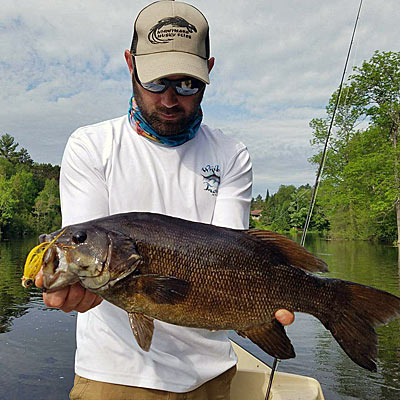
Sandrone’s version of the Deceiver pattern, the stalwart baitfish imitator, also is articulated. “We’re all going that way,” he said of his fellow fly tiers. “Even a 20-millimeter shank on the front makes [a fly] swim like it’s alive.” His most productive smallmouth streamer of late is 6 inches long, made of craft fur, and named Big Bird. Its backbone is a 28-millimeter shank followed by a 2/0 hook.
Sandrone’s streamers have something else in common. They include some shade of yellow, straight like a banana, or a derivative such as orange or chartreuse. That’s because most baitfish, including the suckers, shad, and perch that river smallmouth eat, have some yellow coloration. He ties his Big Bird fly, for example, in solid yellow.
Yellow also makes it easier to see your streamer and what is happening in the water around it. “It shows up super and better than white sometimes,” Sandrone said. He watches about 70 percent of the smallmouth he catches eat his streamer, which he fishes in water from clear to muddy. Most of it is tannic, stained the color of iced tea from decaying organic matter. Under those conditions, he might only see a green or white splotch on a smallmouth’s body or a twitch of its tail. It takes a trained eye. “You have to be on it,” he said.
Sandrone said many smallmouth grab his streamer and swim off as a second bass tries to take it away. That forces the first bass to eat it again, giving him a better shot at a solid hook-up. Using a highly visible streamer makes that easier to decipher. “I’ve watched more smallmouth bass come out and [stalk his streamer] like a musky,” he said.
None of the streamers in Sandrone’s box are less than 6 inches long. On a recent trip for largemouth, 16- and 17-inch fish were hitting Sandrone’s 11-inch fly. He has watched smallmouth strike conventional musky lures as long as 16 inches. “There isn’t a limit to what they are going to try,” Sandrone said. Even small ones are brave. Some of those caught by anglers casting flashy conventional lures in the spring are barely twice the length of the lure.
Sandrone lets the smallmouth dictate his retrieves. That’s because what they want changes every day. But once he finds the best one, he said it works everywhere on the river or lake. It usually involves two slow strips followed by a pause. He said smallmouth are most likely to hit during the pause. That’s when articulated streamers work their magic, randomly diving to one side or the other. And as all smallmouth anglers know, erratic action generates strikes.
Sandrone aims his casts at cover and structure that’s not obvious. They’re the type of spots that an angler fishing conventional tackle would cast a jig. The smallmouth holding there are in tune with food swimming rather than floating across the surface, where they feed only under low-light conditions. On the rivers, he frequently fishes for smallmouth. He keeps his boat in the center, concentrating on current edges and seams. He’ll cast perpendicular to the boat when the current runs strong, letting it carry his streamer downstream and across key spots. That puts it in front of more smallmouth and provides plenty of time for them to chase it down and eat it. He said the strike usually happens as the streamer straightens behind the boat.
While most fly anglers reach for an 8-weight rod to cast these larger streamers, Sandrone prefers a 5/6-weight rod that’s 8 ½-feet long. He says it will handle any smallmouth he comes across. He doesn’t give much thought to his reel, which he only uses to hold the line. While smallmouth pull, they don’t make screaming runs like steelhead, so he never fights them with the reel, eliminating the need for a fancy drag or large arbor that quickly collects slack.
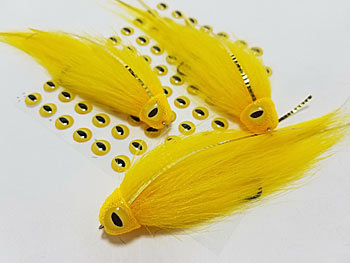
Sandrone rigs his rod with a floating line when the water is low and slow. When it’s not, he uses a 200-grain sinking line. He said it increases control of his retrieve, even in shallow water, and helps cast big streamers farther. It takes practice to cast extra weight, especially if you’ve only used floating line. To help make the jump, he suggests starting with an intermediate line, which, as its name implies, is lighter than sinking line but heavier than floating line.
Sandrone’s leaders are usually 5 or 6 feet long and made of stiff monofilament or fluorocarbon. He uses the latter when fishing floating line. It sinks, taking his streamer with it. Many times he’ll use the butt section of a tapered leader.
Tapering helps a leader roll out at the end of the cast, depositing the fly at its farthest point from the fly line. But heavier streamers don’t need that help, and their extra weight can collapse lighter leaders. That’s why Sandrone prefers 20-pound test line. It won’t collapse as his cast rolls out and offers plenty of control over a strong smallmouth. “In a second, they can have you in a tree,” he said.
Sandrone’s casts aren’t the 90-footers expert trout anglers let fly. He’s more concerned with accuracy, especially in the tighter confines of the rivers he fishes. He modifies his casting motion, opening it beyond the tight 10 o’clock to 2 o’clock movement that many instructors preach. He holds his casting arm’s elbow farther from his body and twists his hips in concert with his casting motion. That gives him a mechanical advantage, making moving the heavier sinking line easier. He also doesn’t worry about double hauling, the extra tug that adds line speed during the cast to generate extra distance.
Sandrone said care is needed when handling the bigger smallmouth that streamers catch. Minimizing the time they are fought, handled, and held for photographs increases their odds of survival. Even letting one revive inside a landing net before release helps, especially in a river, where woozy bass can be swept downstream.


